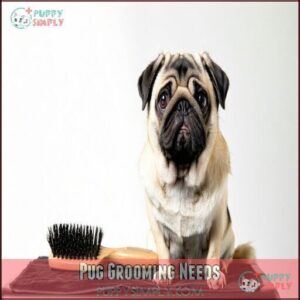This site is supported by our readers. We may earn a commission, at no cost to you, if you purchase through links.
 When you’re deciding between a pug vs frenchie, you’re in for a tough choice.
When you’re deciding between a pug vs frenchie, you’re in for a tough choice.
Both breeds pack a punch of cuteness into tiny packages. Pugs bring wrinkly faces and clownish personalities, while French Bulldogs sport muscular builds and bat-like ears.
They’re both apartment-friendly companions that’ll steal your heart faster than you can say "adorable." Frenchies tend to be slightly more energetic and sturdy, whereas pugs are ultimate cuddle champions.
Health-wise, both breeds have respiratory challenges, so you’ll want to chat with a vet. Your lifestyle and living space will ultimately determine which compact companion fits best.
Spoiler: whichever you choose, you’re in for a world of snuggles and personality.
Table Of Contents
- Key Takeaways
- Pug Vs Frenchie Origins
- Breed Physical Differences
- Temperament Comparison
- Exercise and Nutrition Needs
- Grooming and Health Issues
- Intelligence and Trainability
- Lifestyle and Considerations
- Choosing The Right Breed
- Final Decision Considerations
- Frequently Asked Questions (FAQs)
- What is the difference between a French Bulldog and a pug?
- Are Pugs and French Bulldogs the same breed?
- Are French Bulldogs and Pugs good pets?
- Is it easier to train a French Bulldog than a Pug?
- How much does a French Bulldog vs Pug cost?
- Does a French Bulldog bark less than a Pug?
- Which is better, Pug or French Bulldog?
- Do Pugs live longer than Frenchies?
- Is the Pug the friendliest dog?
- Which is better, Pug or bulldog?
- Conclusion
Key Takeaways
- You’ll find both Pugs and French Bulldogs are excellent apartment-friendly companions with distinct personalities, so your choice depends on whether you prefer a goofy (Pug) or more reserved (Frenchie) temperament.
- Health considerations are crucial, as both breeds have respiratory challenges and require specialized care, so you’ll want to budget for potential veterinary expenses and invest in pet insurance.
- Their exercise needs are similar – low-intensity and short – making them perfect for owners who can’t commit to long, strenuous walks or intense physical activities with their dog.
- While initially similar in appearance, these breeds differ significantly in origin, physical build, and personality, so you’ll need to research thoroughly to find the companion that best matches your lifestyle and preferences.
Pug Vs Frenchie Origins
If you’re curious about the fascinating backstories of these adorable wrinkly-faced companions, you’ll be surprised to learn that Pugs and French Bulldogs have roots that couldn’t be more different.
While Pugs traveled from ancient China to European royal courts, French Bulldogs actually originated in England before becoming the Parisian darlings we recognize today, with roots that highlight their unique histories.
French Bulldog History
Every breed has a story, and the French Bulldog’s journey is a tale of transformation from English origins to French fame.
A humble breed born in England, transformed by Parisian passion — the French Bulldog’s tale is one of unexpected global charm.
Let’s explore their fascinating history with this quick reference:
| Era | Location | Key Development |
|---|---|---|
| 1835 | England | Bull-baiting banned |
| 1850s | Nottingham | Lace workers breed smaller bulldogs |
| 1860s | France | Breed gains popularity |
| 1880s | Paris | Becomes artistic elite’s companion |
| Early 1900s | Worldwide | Global breed recognition |
These compact companions evolved from working-class roots to become beloved global icons, with a history that showcases their transformation over time.
Pug Ancient Roots
While French Bulldogs captured European hearts, the Pug’s story stretches back millennia in China.
These adorable companions weren’t just pets—they were imperial treasures. Let’s explore their fascinating journey from royal courts to global adoration.
Imperial companions: from royal courts to global hearts, these pups traveled centuries of love and admiration.
| Ancient Detail | Fascinating Fact |
|---|---|
| Origin | China, circa 400 BCE |
| Royal Status | Emperor’s Lapdog |
| Breed Purpose | Companion & Entertainment |
| Global Spread | Netherlands, Europe |
Their wrinkled faces and compact bodies whispered tales of luxury, marking Pugs as more than just dogs—they were living symbols of status and affection.
Early Uses of Pugs and French Bulldogs
Because of their fascinating historical roles, Pugs and French Bulldogs emerged from distinctly different paths of purpose and companionship.
Their breed origins reveal remarkable stories of survival and adaptation.
| Breed | Original Purpose | Historical Context |
|---|---|---|
| Pug | Royal Companions | Chinese Imperial Courts |
| French Bulldog | Ratters/Companions | English Lace Workers |
| Both | Companion Animals | Evolving Social Landscapes |
Their roles as companion animals have evolved over time, reflecting changing social landscapes and human needs.
Breed Physical Differences
You might think Pugs and French Bulldogs look similar, but their physical differences will surprise you.
From ear shapes to coat colors, these adorable breeds have unique characteristics that set them apart and make each one a distinct bundle of cuteness.
Pug Physical Characteristics
Meet the Pug: a compact bundle of joy standing 10-14 inches tall and weighing 14-18 pounds.
These flatfaced dogs boast a distinctive wrinkled face, small floppy ears, and a tightly curled tail.
With a dense, coarse coat in black or fawn, Pugs embody adorable proportions that’ll steal your heart.
Their unique pug characteristics make them irresistible little companions with big personalities.
French Bulldog Physical Characteristics
Moving from pugs, you’ll find French Bulldogs stand out with their muscular build and distinctive batlike ears.
These brachycephalic charmers pack serious personality into a compact frame.
Weighing 20-28 pounds, they’re sturdy, flat-faced dogs with a solid, athletic body type.
Their short, smooth coat highlights their impressive muscle mass, making them look like tiny bodybuilders ready to steal your heart with their compact frame.
Coat Colors and Patterns
Building on the French Bulldog’s distinctive physique, their coat colors are equally eye-catching.
Here’s what makes their fur unique:
- Standard colors include cream, fawn, white, and brindle
- Combinations offer stunning visual variety
- Single-colored coats range from pale to deep shades
- Brindle patterns create tiger-like striped appearances
- Rare color combinations fetch higher breeding prices
Your frenchie’s coat tells a vibrant story of genetic diversity and aesthetic charm, with rare color combinations being particularly notable.
Temperament Comparison
If you’re torn between a Pug and a French Bulldog, understanding their temperament is key to finding your perfect furry companion.
You’ll discover these adorable breeds might seem similar at first glance, but they’ve got unique personality quirks that could make all the difference in your dog-loving heart.
Pug Personality Traits
After sizing up the Pug’s physical charm, let’s explore their charming personality.
Pugs are the comedians of the canine world, bringing endless joy and mischief to any home.
Their goofy, child-like nature guarantees you’ll never have a dull moment.
| Trait | Description | Fun Factor |
|---|---|---|
| Loyalty | Deeply devoted | High |
| Playfulness | Clownish antics | Extreme |
| Affection | Cuddle champions | Maximum |
| Intelligence | Clever but stubborn | Moderate |
These wrinkly-faced jesters will steal your heart with their irresistible charm and unwavering companionship, making them a perfect companion for a fun-filled life with endless joy and mischief.
French Bulldog Personality Traits
After your pug’s playful antics, you’ll find French Bulldogs offer a different charm.
These compact companions bring unique frenchie temperament traits that’ll win your heart.
Their emotional intelligence shines through loyalty and social behavior.
| Trait | Description | Impact |
|---|---|---|
| Playfulness | Moderate engagement | Family-friendly |
| Loyalty | Deep connection | Strong bond |
| Social Skills | Adaptable personality | Easy integration |
Frenchies balance calm demeanor with occasional bursts of goofy energy, making them irresistible dog personality companions.
French Bulldogs with merle genetic traits require special care due to their unique characteristics, showcasing their need for special care and deep connection with their owners, which is a key aspect of their emotional intelligence.
Trainability and Adaptability
After capturing your heart with their adorable personalities, both pugs and French bulldogs prove they’re more than just cute faces.
Their trainability and adaptability shine through different approaches.
Check out how these lovable companions stack up:
| Trait | Pugs | French Bulldogs |
|---|---|---|
| Intelligence | Quick learners | Willing to please |
| Training Style | Positive rewards | Gentle reinforcement |
| Socialization | Easily frightened | Adaptable companions |
| House Training | Slow progress | Responsive learners |
| Behavior | Playful & curious | Alert & independent |
These charming pups will steal your heart with their unique temperaments and trainable spirits! They are lovable companions with adorable personalities and are considered quick learners.
Exercise and Nutrition Needs
If you’re eyeing a pug or French bulldog, you’ll want to understand their unique exercise and nutrition needs.
These flat-faced companions might look similar, but their metabolic requirements and activity levels can surprise you, so buckle up for some breed-specific insights that’ll keep your furry friend healthy and happy.
Pug Exercise Requirements
Your petite pug’s exercise routine requires a delicate balance.
Daily walks are essential, but don’t overdo it.
Here’s what you need to know about pug exercise needs:
- Limit walks to 20-40 minutes daily
- Avoid intense exercise in hot weather
- Break playtime into short, gentle sessions
Moderate activity maintains their health without stressing their brachycephalic respiratory system.
Remember, these adorable companions prefer cuddles to marathons.
When walking your pug, using a pug harness is essential for their comfort and safety.
French Bulldog Exercise Requirements
French Bulldogs thrive on moderate physical activity.
Daily walks and short playtime sessions meet their exercise requirements without overdoing it.
These compact pups have exercise limits due to their flat faces, which can make breathing tricky.
Keep frenchie exercise light yet consistent to maintain health benefits.
Always watch for overheating—Frenchies prefer lounging over marathons any day!
Dietary Needs for Pugs and French Bulldogs
Your furry friend’s digestive health hinges on a strategic nutrition plan customized to their unique needs.
When feeding pugs and French bulldogs, focus on:
- High-quality protein sources
- Balanced caloric intake
- Allergen-free ingredients
- Age-appropriate diet
Consult your vet to craft a personalized feeding schedule that supports ideal dog nutrition and prevents potential health complications.
A well-planned raw food diet can have numerous benefits for their overall health.
Grooming and Health Issues
When you’re considering a Pug or French Bulldog, you’ll need to understand their unique grooming challenges and potential health concerns.
These adorable flat-faced breeds require specialized care that goes beyond typical dog maintenance, so you’ll want to be prepared for their specific needs.
Pug Grooming Needs
Your pug’s grooming routine is simpler than you might think.
With their short, dense coat, these wrinkly charmers need weekly brushing to manage shedding and maintain skin health.
Pay special attention to those adorable facial wrinkles, cleaning them gently to prevent infections.
Regular nail trims and ear checks are essential for keeping your pug looking and feeling fabulous.
To keep their coat in top condition, consider using a Pug Brush tool as part of their regular grooming routine.
French Bulldog Grooming Needs
Bulldogs demand minimal grooming, but don’t be fooled—their care routine matters.
Frenchie grooming requires consistent attention to keep them looking sharp.
Here’s your game plan:
- Brush their short coat weekly to control shedding and distribute natural oils
- Clean skin folds carefully to prevent irritation and bacterial buildup
- Trim nails monthly and check ears regularly for potential infections
Their care is crucial for maintaining their overall health and appearance, making it essential to follow this game plan.
Common Health Issues in Pugs
After keeping your Frenchie’s coat pristine, you’ll want to understand Pugs’ hidden health challenges.
These adorable flat-faced companions battle serious genetic disorders, with Brachycephalic Obstructive Airway Syndrome making breathing a struggle.
Their bulging eyes, wrinkled skin, and compact frame predispose them to respiratory, orthopedic, and eye problems that demand vigilant veterinary care and proactive monitoring.
Understanding pet insurance costs is vital for managing these expenses and ensuring the best care for your Pug.
Intelligence and Trainability
You might wonder how smart these adorable flat-faced pups really are when considering a new furry friend.
Whether you’re drawn to the goofy Pug or the charming French Bulldog, understanding their unique intelligence and trainability will help you choose the perfect companion that’ll match your lifestyle and training expectations.
Pug Intelligence and Trainability
Intelligence in pugs is a nuanced journey of adaptability and charm. While not topping obedience charts, these adorable companions showcase remarkable emotional intelligence that’ll win your heart.
- Mid-range cognitive abilities don’t define their potential
- Patience transforms training challenges into delightful moments
- Emotional connection trumps traditional canine intelligence metrics
- Individual personality shapes learning capabilities
- Positive reinforcement reveals their hidden talents
The key aspects of a pug’s intelligence include their ability to form strong emotional connections and their unique learning capabilities.
French Bulldog Intelligence and Trainability
Building on pugs’ cognitive quirks, French Bulldogs showcase their own breed intelligence.
While not top-tier in canine cognition, Frenchies excel at reading human emotions and adapting to training methods.
Their learning style prioritizes connection over complex commands, with patience and positive reinforcement being key to unlocking their potential.
With these approaches, you’ll release their potential in dog obedience, transforming these adorable companions into responsive, enthusiastic learners, and ultimately forming a strong bond.
Training Tips for Pugs and French Bulldogs
With patience and positive reinforcement, training your Pug or French Bulldog becomes a delightful journey.
Leverage clicker methods and reward systems to make housebreaking and leash training engaging.
Socialization techniques are essential for these breeds, helping them develop confidence and adaptability.
Remember, consistency is key in dog training tips that work for both lovable companions.
Lifestyle and Considerations
Before you bring home a Pug or French Bulldog, you’ll want to think about how these adorable companions fit into your lifestyle and living space.
Whether you’re in a cozy apartment or a spacious home, understanding each breed’s unique needs will help you make the perfect furry friend match, and ensure that your new companion fits well into your lifestyle.
Suitable Living Situations for Pugs
If training your pug felt like tackling canine complexity, finding the perfect home is much simpler.
Urban homes and apartment life are ideal for these compact companions, with their small size and adaptable pug temperament.
They thrive in cozy spaces, and city living suits them perfectly, provided they receive plenty of love, regular short walks, and climate-controlled comfort.
Suitable Living Situations for French Bulldogs
After keeping pugs happy in tight spaces, French Bulldogs offer similar adaptability.
Your Frenchie thrives in various living situations, making them perfect urban companions.
They’re ideal for:
- Compact city apartments
- Cozy suburban homes
- Small living spaces
- Low-maintenance environments
These adorable bulldogs adjust seamlessly, whether you’re in a high-rise or a modest townhouse, proving size doesn’t limit their lovable nature.
Traveling With Pugs and French Bulldogs
Your luggage-and-puppy travel kit becomes your best friend when road-tripping with a pug or French bulldog.
These compact travel companions require careful planning, especially considering their brachycephalic breathing challenges.
Invest in airline-approved dog carriers, research pet-friendly hotels, and pack essentials like cooling mats and plenty of water to guarantee a comfortable journey for your adorable four-legged friend.
Choosing The Right Breed
You’re about to set out on a tail-wagging journey of choosing between two adorable flat-faced companions: the playful Pug and the charming French Bulldog.
Before you bring home your new furry friend, you’ll want to ponder factors like living space, lifestyle compatibility, and the unique personality quirks that make each breed special.
Factors to Consider When Choosing
When choosing between a pug and a Frenchie, weigh your family’s unique needs carefully.
Consider your living space, budget, and potential health concerns.
Cost comparisons reveal both breeds have similar veterinary expenses, while breed compatibility depends on your lifestyle.
Pug vs Frenchie isn’t just about cuteness—it’s about finding your perfect four-legged companion that fits seamlessly into your world, considering the unique needs of your family.
Research and Preparation for Dog Ownership
Often, dog ownership demands more than just love—it requires strategic preparation. Research is your golden ticket to successful pet parenting.
Consider these critical steps:
- Assess your family’s lifestyle and budget
- Calculate potential dog costs and veterinary expenses
- Review pet insurance options thoroughly
Dive deep into breed selection, understanding pug vs frenchie nuances to make a perfect match for your home dynamics.
When selecting a breeder, this is vital to understand the breeder selection process to make an informed decision.
Pug Vs Frenchie: Which is Better?
After exploring dog ownership, you’re ready to pin down the perfect pooch.
Comparing pugs and French Bulldogs isn’t just about cuteness—it’s about finding your furry soulmate.
Check out this quick breed breakdown:
| Feature | Pug | French Bulldog |
|---|---|---|
| Size | Smaller | Slightly Larger |
| Personality | Goofy | Calm |
| Exercise Needs | Low | Low |
| Grooming | Easy | Easy |
| Health Concerns | Moderate | Moderate |
Your ideal companion awaits—choose wisely!
Final Decision Considerations
You’ve weighed the pros and cons of pugs and French bulldogs, and now it’s time to make the ultimate companion choice.
Your decision will depend on lifestyle, living space, and personal preference, so trust your instincts and choose the adorable breed that’ll steal your heart, considering your ultimate companion needs.
Making an Informed Decision
At the crossroads of pet ownership, your dog comparison journey demands careful reflection.
Weigh your family needs against each breed’s unique characteristics: pugs and French Bulldogs offer different lifestyle matches.
Consider health implications, temperament nuances, and personal compatibility.
Your decision isn’t just about cuteness—it’s about finding a furry companion who’ll seamlessly integrate into your daily rhythm, ensuring a harmonious match based on lifestyle matches.
Preparing Your Home for a New Dog
After making your breed decision, it’s time to transform your home into a pug or Frenchie paradise.
Dog proofing isn’t just a checklist—it’s creating a safe haven. Secure loose wires, remove toxic plants, and designate cozy pet zones.
Arrange furniture to create clear pathways, protect your floors with washable rugs, and prepare a comfortable bed that’ll make your new furry friend feel right at home.
Providing the right dog bed options is essential for their overall comfort and well-being.
Final Tips for New Dog Owners
You’ve prepped your home—now seal the deal with smart dog care tips.
Get pet insurance early, schedule regular vet check-ups, and invest in positive training methods.
Budget for ownership costs and embrace your new furry friend’s unique personality.
Remember, whether you’re team Pug or Frenchie, consistent love and patience create the strongest bond.
Frequently Asked Questions (FAQs)
What is the difference between a French Bulldog and a pug?
While both compact and cuddly, Pugs charm with wrinkly faces and curled tails.
French Bulldogs flex muscular builds with bat-like ears.
They’re adorable companions differing in size, coat, and personality—yet equally lovable family pets, with cuddly being a key characteristic that makes them endearing.
Are Pugs and French Bulldogs the same breed?
No, Pugs and French Bulldogs aren’t the same breed.
They originated from different regions: Pugs from China and French Bulldogs from England.
While both are small companion dogs, they’ve distinct physical and genetic characteristics, making them unique breeds with distinct features.
Are French Bulldogs and Pugs good pets?
If you’re seeking a loyal, low-maintenance companion, both French Bulldogs and Pugs shine as fantastic pets.
They’re affectionate, adapt well to apartments, and love cuddles, making them perfect for families who want a charming, easygoing furry friend, and they are also very low-maintenance.
Is it easier to train a French Bulldog than a Pug?
You’ll find French Bulldogs slightly easier to train due to their more attentive nature.
Pugs can be stubborn and easily distracted, while Frenchies are more focused and keen to please their owners during training sessions.
How much does a French Bulldog vs Pug cost?
Your wallet’s about to feel the pinch!
French Bulldogs range from $2,000-$7,000, while Pugs typically cost $1,000-$3,
Expect higher prices for rare colors or champion bloodlines, with ongoing expenses like healthcare and grooming.
Does a French Bulldog bark less than a Pug?
You’ll find French Bulldogs bark less than Pugs.
Their laid-back nature means fewer vocal outbursts, making them quieter companions.
While both breeds are relatively silent, Frenchies tend to be more reserved and less prone to excessive barking.
Which is better, Pug or French Bulldog?
Both adorable companions have unique perks.
French Bulldogs suit active families wanting a more serious pet, while Pugs charm with constant goofiness.
Your lifestyle, living space, and personal preference will ultimately determine the perfect furry friend for you, based on your lifestyle.
Do Pugs live longer than Frenchies?
Picture two adorable pups racing the clock of life.
Pugs typically outlive French Bulldogs by about a year, averaging 11-12 years compared to Frenchies’ 10-11 years, thanks to slightly fewer breed-specific health complications.
Is the Pug the friendliest dog?
Pugs are certainly friendly, but they’re not the ultimate champion of canine friendliness.
They’re goofy, loyal companions who’ll shower you with love, but other breeds might edge them out in the friendliness department.
Which is better, Pug or bulldog?
By pure chance, when life throws you a curveball, choosing between a Pug and a French Bulldog depends on your lifestyle.
Both are lovable companions, but Frenchies edge out with fewer health issues and more adaptable personalities.
Conclusion
Remember when you first fell in love with those squishy faces?
Whether you choose a pug or French Bulldog, you’re signing up for a lifetime of companionship.
Your "pug vs frenchie" decision isn’t just about looks—it’s about finding a furry friend who matches your lifestyle.
Both breeds offer unique charms, so trust your instincts, research, meet the dogs, and let your heart guide you to your perfect compact companion.



















